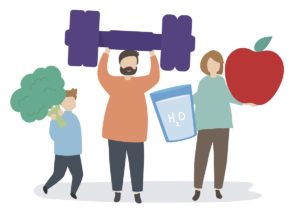Reaping The Benefits of a Fitness Program One Year After an Injury
One year ago, I had a back injury. It did not happen when I was skydiving nor when I was skiing on the black diamond trail, but rather when I was trying to get on a hammock! As silly as it sounded, I had to stay home for few weeks and suffer from pain and limited function for long period afterwards. As my pain started to become chronic, I started questioning whether this is the inflection point for me.
They say you don’t appreciate what you have until you lose it. I have enjoyed good health all my life, so this was the first time I felt disabled. It made me realize how vulnerable we are.
For the first time, I started to seriously think that my health should not be taken for granted and I should be doing an effort to maintain and improve it. As a doctor for many years now, you would think that I should’ve learned my lesson earlier, seeing patients every day losing the health they enjoyed, even in more dramatic ways. But, somehow I didn’t.
I work around 80 hours a week between my clinical duties, research work, and other career-building activities. My career always took priority over any effort to maintain my health, such as regularly working out at a gym. If I ever took time off to disconnect from work, I felt guilty by my lack of productivity. If I ever felt burnt out, I powered through, and then rewarded myself with an unhealthy meal, such as a burger, in front of the TV.
The following day in clinic, I would spend hours preaching my patients how they should eat healthier and exercise at least 3 hours a week!
While this approach served my career pretty well, it was clearly taking a toll on my well-being and the back injury was nothing but a wake up call; so I decided to take action. My priority was improving my cardiovascular fitness, improving my core strength, building more muscle, and losing waist fat. It was clear to me that if I were to achieve those goals, I really need to prioritize working out at the gym over work.
That meant that even in the face of many passed deadlines and endless work commitments, I would still go to the gym at least four days a week for at least an hour each time.
I knew I needed motivation, so I looked for the nicest and most convenient gym, which unfortunately was also the most expensive. I then convinced my wife and a close friend to join me, but promised myself that I would maintain my schedule without them. Because I was never a gym regular, I felt I would benefit from professional guidance, so I hired a personal trainer. Michael is 10 years younger than me but probably 100 times more fit. He has a bachelors degree in exercise physiology and has gone through rigorous training of how to become trainer, which I’ve come to discover requires incredible talent in terms of interpersonal skills, ability to motivate, and solid understanding of the science of fitness.
A year later, I’m still a regular at the gym and I achieved all my goals. I feel healthier, more fit and stronger than I ever was. More importantly, I discovered benefits of fitness that I never thought possible. My fitness program made me:
1- … healthier
A year later, I feel healthier than ever. I am able to stand or work on a computer for long hours without having any neck or back aches.
2- .. look better
With the belly fat gone and the shoulders, arms and chest larger, I never looked any better in shirts I’ve had for years.
3- … a better doctor
I finally can preach what I do. I also learned a ton about exercise physiology and how to motivate behavior change.
4- … more productive
Although gym hours took time that otherwise I could spend working, I became more productive in the hours that I am working. An hour at the gym boosts my motivation and focus and allows me to produce more in shorter period of time.
5- … happier
Overall, achieving a more balanced lifestyle made me happier.
 When I was a nutrition intern in 2014, I would excitedly tell patients that walking 30 minutes a day, 5 days a week doesn’t have to be a daunting goal. In fact, research showed that accumulating bouts of 10 minutes conferred cardiac benefits.
When I was a nutrition intern in 2014, I would excitedly tell patients that walking 30 minutes a day, 5 days a week doesn’t have to be a daunting goal. In fact, research showed that accumulating bouts of 10 minutes conferred cardiac benefits.